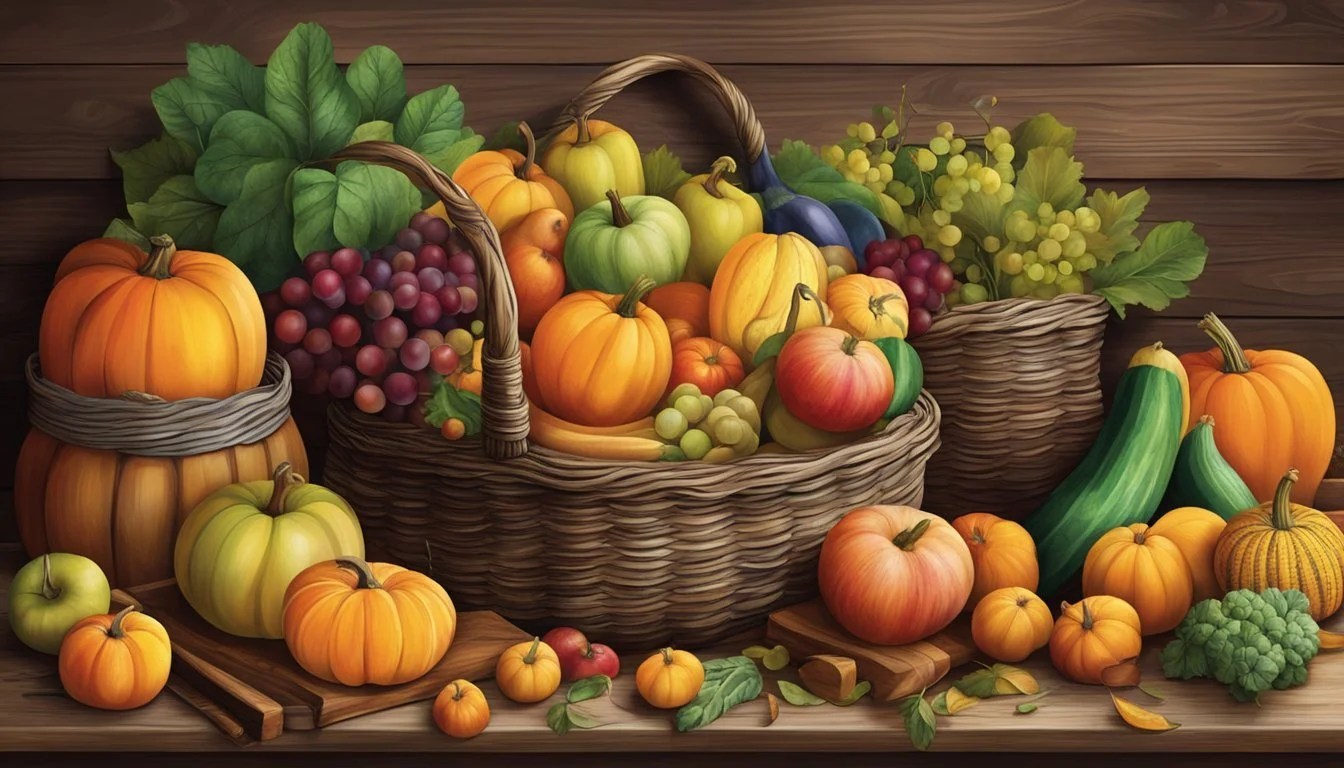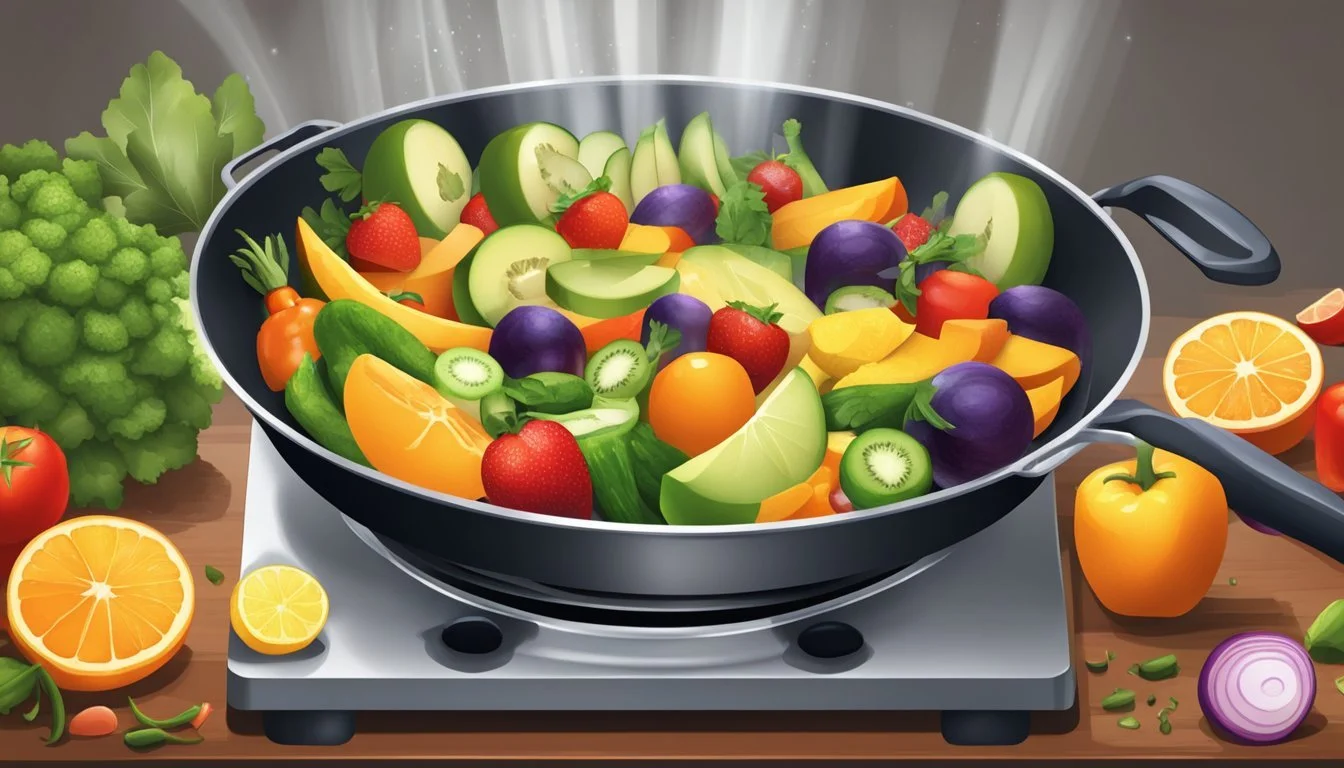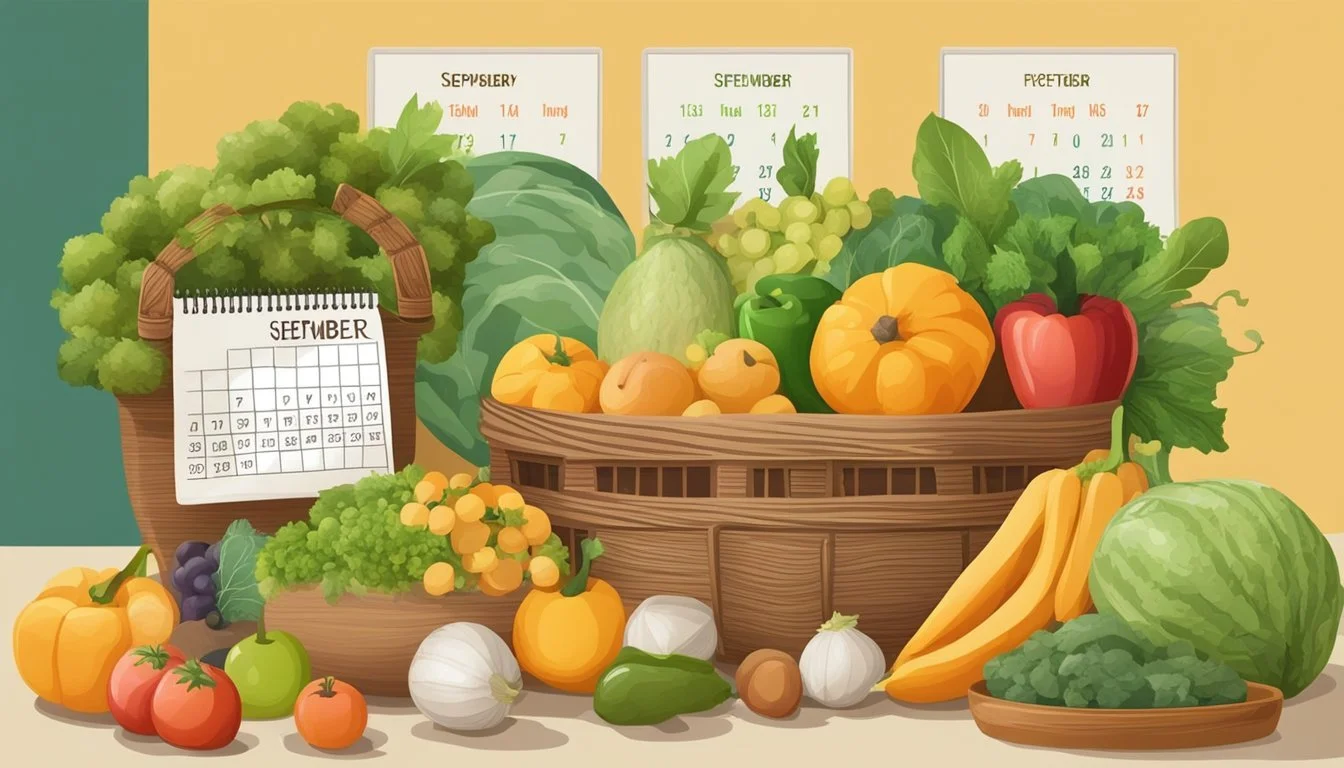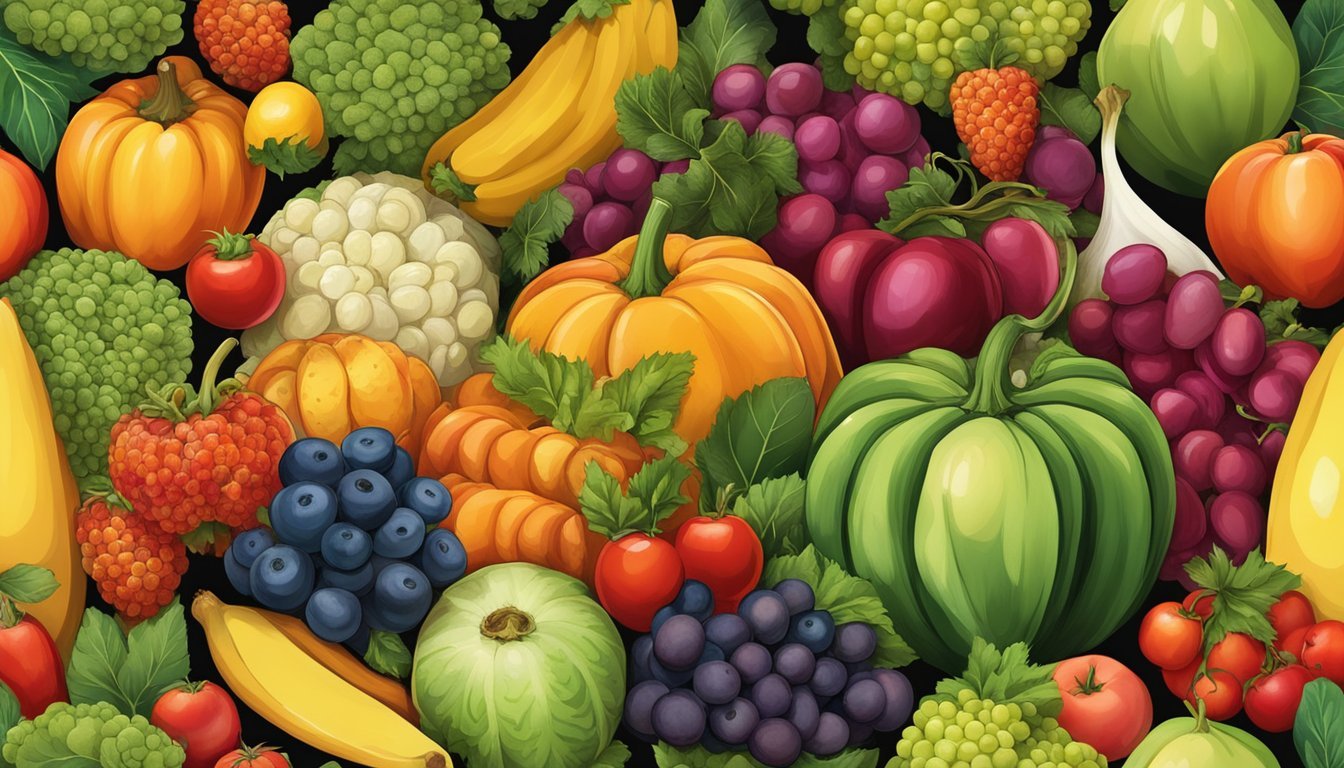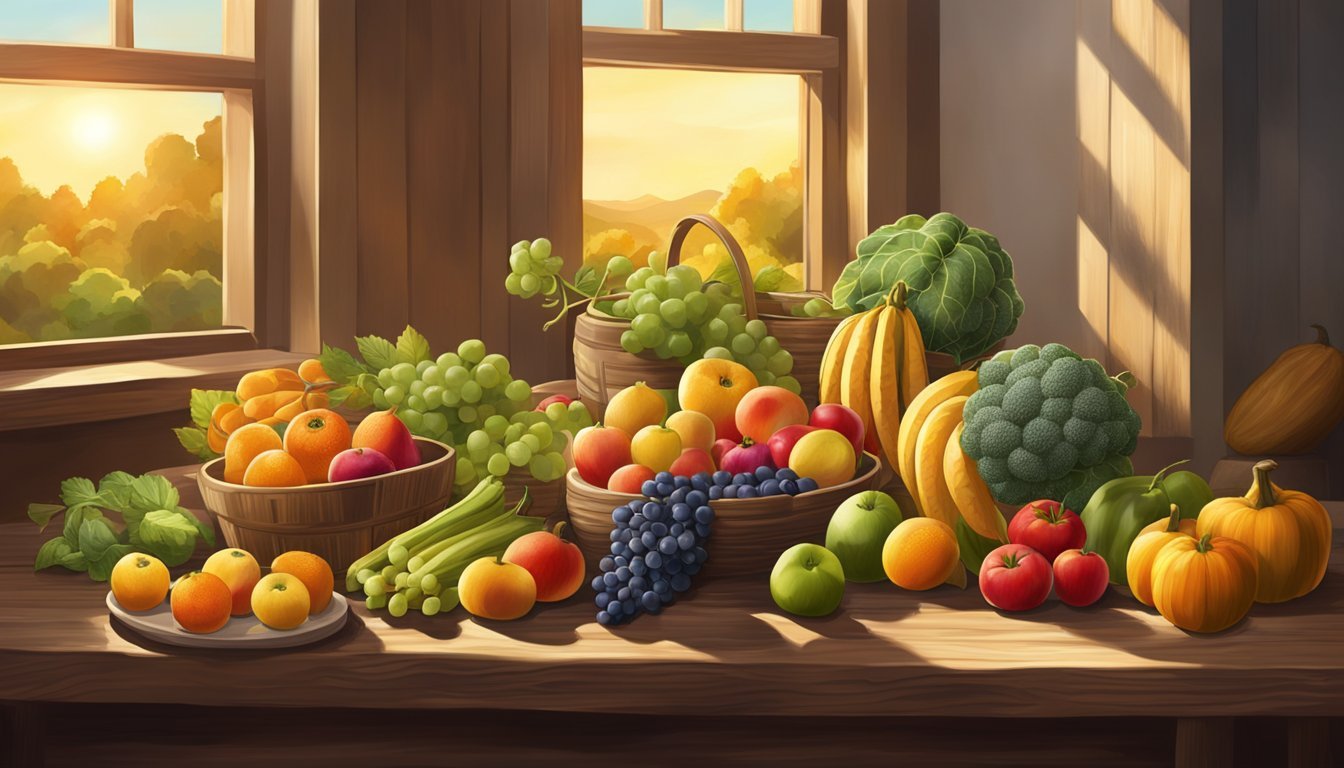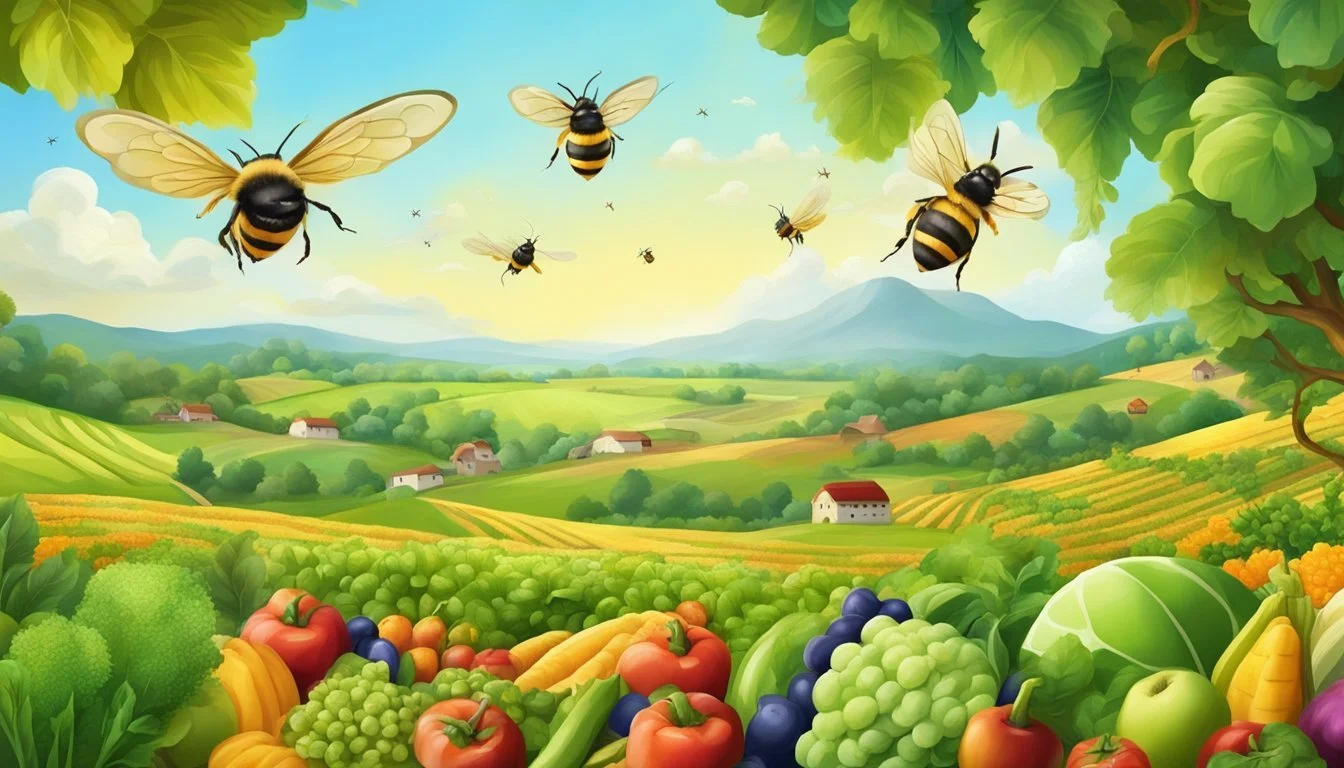Seasonal Fruit and Vegetables September
A Guide to Autumn Harvest
This Article is Part of Our Guide to Seasonal & Local Produce in the USA
September marks a transitional period in the agricultural calendar, offering a bountiful selection of both late summer produce and the first of fall's harvest. It's a unique time when the lingering warmth of summer sun brings forth the final sweetness in fruits like peaches and plums, while cooler evenings signal the arrival of autumn favorites such as apples (how long do apples last?) and pears.
During this month, seasonal eating not only supports local agriculture but also provides the highest quality of fresh produce. Vegetables like bell peppers, cauliflower, eggplants (how long does eggplant last?), and tomatoes are at their most flavorful as they peak in ripeness. September's generous variety inspires a rich palette for both sweet and savory culinary creations, from hearty stews to fresh salads.
The availability of produce can vary based on region, but the consensus among local farmers and seasonal guides suggests a diverse offering. Stone fruits continue to deliver their juicy delight, while blackberries and cranberries introduce a tart contrast, perfect for baking or as toppings. The harvest extends to include an array of greens, squashes, and root vegetables, setting the stage for nutritious and colorful meals throughout the month.
What’s in Season in September in Your State?
Texas Seasonal Fruit and Veg in September
Overview of September Produce
September brings a transition in the produce available, with a blend of summer's tender offerings and the first hints of fall's ripe bounty. Here's a snapshot of what fruits and vegetables are at their peak during this month.
Prime Fruits
Apples: A staple of fall, apples come into their prime in September. Varieties such as Honeycrisp and Gala become especially flavorful and crisp during this time.
Pears: Also reaching peak ripeness, pears like Bartlett and Anjou provide a juicy, tender texture, perfect for a range of dishes.
Featured Vegetables
Bell Peppers: Rich in color and flavor, bell peppers maintain their sweetness and firm texture throughout September.
Cauliflower: This versatile vegetable comes into season, offering a nutty, slightly sweet flavor when cooked.
Tomatoes: Although peaking in summer, tomatoes remain vibrant and ripe, with heirloom and cherry varieties available through September.
Cucumbers: Crisp and refreshing, cucumbers continue to be a seasonal favorite, transitioning well into early fall salads and sides.
Eggplants: With their glossy skins, eggplants are tender and at their best in early September, suitable for a variety of culinary applications.
Green Beans: Still tender and flavorful, green beans can be enjoyed fresh from the garden or the market in the early part of the month.
September's produce offers a diverse palette of flavors that inspire both hearty and light dishes, (What wine goes well with light dishes?) suitable for the shift in season.
Health Benefits of Seasonal Consumption
Consuming fruits and vegetables during their peak season can provide significant health advantages. September offers an array of produce that is not only flavor-rich but also densely packed with nutrients.
Nutrient Density: Seasonal produce is often harvested at optimal ripeness, meaning it can contain higher levels of nutrients. For example, pumpkins, a star of the September harvest, are high in vitamins and minerals while also providing a good source of fiber.
Immune Support: Seasonal fruits and vegetables can help in strengthening the immune system. High in antioxidants, they play a crucial role in combating inflammation and bolstering the body's defense against common illnesses.
Variety in Diet: Eating seasonally introduces diversity to the diet, which is beneficial for obtaining a wide range of nutrients and fiber. This assortment is key for maintaining a healthy gut and promoting better overall health.
Sustainable Choice: Opting for seasonal produce supports local farming and reduces the environmental footprint associated with long-distance transportation.
In September, individuals can enjoy an assortment of produce such as:
Stone fruits: Peaches and plums, delivering a juicy source of vitamins.
Berries: Raspberries and blackberries, which are fiber-rich and high in antioxidants.
Leafy Greens: Kale and spinach, offering a wealth of essential minerals.
Fruit/Vegetable Nutrient Contribution Pumpkin Vitamins A & C, Fiber Berries Antioxidants, Fiber Leafy Greens Vitamins K, A, C, Calcium
By choosing seasonal items, consumers ensure that their intake of fruits and vegetables is not only fresh and environmentally conscious but also beneficial for their health.
Sourcing September Produce
In September, consumers can find a bounty of fresh, local produce in the United States. This month marks a transitional period when summer fruits and vegetables are still available, while autumn harvests begin to surface.
Farmers' Markets
Visitors to farmers' markets can expect a diverse assortment of produce picked at peak ripeness. These markets typically offer:
Fresh apples: Many varieties, such as Gala and Fuji, are in season.
Pears: Look for Bartlett or Anjou pears.
Root vegetables: Carrots and beets (how long do beets last?) bare often available.
Leafy greens: Varieties like kale might be found.
Bell peppers: These are often still in season from summer crops.
Farmers' markets are ideal for sourcing local produce, ensuring that consumers support regional agriculture and enjoy fruits and vegetables that haven't traveled long distances.
Supermarkets
Supermarkets nationwide stock a mix of locally sourced and imported produce. September selections often include:
Cauliflower: Fresh and local, when possible.
Zucchini: A versatile vegetable that may come from nearby farms.
Antioxidants-rich carrots: High in vitamins and fiber.
While supermarkets offer convenience, it's worth checking labels to determine the origin of the produce to ensure freshness and support US growers when possible.
Selection and Storage Tips
When selecting fruit, one should search for specimens that are firm and free of mushy spots. For example, peaches should have a slight give when pressed, indicating ripeness. Upon bringing them home, one can store firm, unripe peaches at room temperature until they reach peak ripeness. Refrigeration can then help prolong freshness, particularly for juicy fruits like plums and berries.
For vegetables such as bell peppers, one should opt for those with taut skin, devoid of wrinkles. They are best stored in the refrigerator's crisper drawer, where the cool, controlled environment keeps them crisp. The same applies to other crisp vegetables like Brussels sprouts, which should additionally have tightly packed florets, indicating they are fresh and not past their prime.
Tomatoes, on the other hand, prefer room temperature settings, as the cold can diminish their flavor and texture. They should be stored on the countertop and used when they are just firm to the touch.
Fruit/Vegetable Selection Criteria Storage Method Peaches Firm, slightly soft to the touch Room temp until ripe, then refrigerate Plums Smooth, free of blemishes Refrigerate Bell Peppers Taut skin, vivid color Crisper drawer in fridge Brussels Sprouts Tightly packed florets, bright green Crisper drawer in fridge Tomatoes Firm, bright color Room temperature
This table provides a clear guide on selecting and storing some September seasonal produce. Following these guidelines will ensure that one's fruits and vegetables maintain their optimal taste and nutritional value for as long as possible after purchase.
September Fruits
In September, consumers can revel in the full swing of harvest season, enjoying a lush array of berries and stone fruits as well as the beginning of core fruit harvests. Exotic fruits also start to make their way into the markets, enriching the produce selection.
Berries and Stone Fruits
Berries: September is the tail end of the season for many berries, but they can still be found fresh and ripe.
Blackberries: They are at their peak, offering a perfect balance of sweet and tart flavors.
Raspberries: These often carry on into the month, making them great for late summer desserts.
Stone Fruits: The stone fruit season begins to wind down, yet a few varieties remain excellent in quality:
Peaches: By September, they are reaching the end of their season, but are still juicy and flavorful.
Plums and nectarines: Often found ripe, they should have vibrant skin and give slightly to pressure.
Core Fruits
Core fruits become prominent in September, marking the transition into autumn.
Apples: A star of the September harvest. Varieties can range from tart Granny Smith to sweet Gala. They are ideal for both eating raw and cooking.
Pears: Pears like Bartlett and Anjou come into season, offering a buttery and sweet taste.
Exotic Varieties
September also sees some exotic fruits, less common but just as anticipated.
Figs: With a sweet, honeyed taste, figs are a decadent choice available in early fall.
Persimmons: Starting to peak, these can range from firm and slightly sweet to soft and cloying when fully ripe.
It's the transition time when late summer fruits are just about finished, and the classic flavors of fall begin to dominate the palate.
September Vegetables
In September, gardens and farmers' markets are rich with a variety of vegetables transitioning from the light, crisp types of summer to the more substantial offerings of fall. This period sees a blend of the final waves of summer yield and the emerging harvests typical of cooler weather.
Flowering Vegetables
Peppers and eggplants are among the flowering vegetables that shine in September. Bell peppers, ranging from green to deep red, are abundant, offering a sweet, crisp bite perfect for both raw and cooked dishes. Eggplants, with their glossy purple skin, come into their prime, lending a creamy texture to a myriad of culinary creations.
Root Vegetables
Root vegetables such as beets and sweet potatoes begin to take center stage. Beets, with their earthy flavor and rich color, are often roasted to enhance their natural sweetness. Sweet potatoes, a versatile root, can be found making their way into both savory dishes and sweet autumnal desserts.
Leafy Greens
Spinach and kale are key leafy greens for September. Spinach, tender and packed with nutrients, provides a versatile ingredient for salads, sautés, and smoothies. Kale, known for its hearty texture and rich, slightly bitter taste, stands up well in cooked dishes and becomes sweeter after a touch of frost.
Seasonal Recipes
As September ushers in the bounty of fall produce, culinary enthusiasts find delight in crafting recipes that highlight the freshest ingredients of the season. From robust appetizers and hearty main courses to indulgent desserts, September's harvest lends itself to a multitude of flavorsome dishes.
Appetizers
Roasted vegetables (What wine goes well with roasted vegetables?) are a staple for September appetizers. A simple dish such as roasted beet salad with walnuts and goat cheese makes use of the earthy root vegetables that are in season. For a refreshing start, cucumber ribbons paired with a light vinaigrette serve as a crisp and hydrating precursor to any meal.
Main Courses
Main courses in September take advantage of the transitional produce available. Stuffed peppers, brimming with rice, tomatoes, and herbs, showcase the late summer harvest, while eggplant parmesan (What wine goes well with eggplant parmesan?) brings the rich flavors of baked eggplant and marinara to the forefront. Meat lovers might opt for a roast that pairs well with a side of apple sauce or roasted root vegetables.
Desserts
September's desserts often feature fruits that are at their peak. Apple-based treats like apple pie and homemade applesauce become favorites. Bakers have their pick of stone fruits for their cakes and pies, with options including plums and peaches. Fresh berry jams and oatmeal with a swirl of apple butter turn everyday meals into seasonal celebrations. For a lighter dessert, smoothies blended with september berries and a hint of honey are a sweet note to end on.
Cooking Techniques
September's seasonal produce offers a great opportunity to employ a variety of cooking techniques, each of which can enhance the natural flavors of the fruits and vegetables available during this time.
Roasting
Roasting enhances the sweetness of fruits and vegetables while giving them a delightful char. Vegetables like bell peppers and root vegetables are transformed when roasted at a high temperature, offering a rich, caramelized flavor and tender texture. Fruits such as apples benefit from roasting, which intensifies their natural sugars, making them perfect for autumnal desserts.
Steps for Roasting:
Preheat your oven.
Prepare produce by cutting into uniform pieces.
Coat lightly with oil.
Season as desired and arrange on a baking sheet.
Roast until fork-tender and caramelized.
Pickling
Pickling offers a way to preserve the abundant produce of September and add a tangy twist to meals. Items such as cucumbers can be transformed into crunchy pickles, a perfect complement to a range of dishes, while pickled apples can offer a unique flavor profile to both sweet and savory dishes.
Basic Pickling Brine:
Water and vinegar at a 1:1 ratio.
Salt and sugar to taste.
Spices like mustard seeds (how long do mustard seeds last?), black peppercorns (how long do black peppercorns last?), or dill (how long does dill last?).
Steaming
Steaming is a gentle cooking method that retains nutrients and the natural flavor of produce. It is especially suitable for delicate items, such as leafy greens which might be found in abundance during September, and unlike frying, steaming avoids adding extra fat.
Guidelines for Steaming:
Use a steaming basket or insert.
Add enough water for steam without submerging the items.
Steam until the produce is brightly colored and tender.
Employing these cooking techniques can bring out the best in September's seasonal produce, whether one is aiming for the deep richness achieved by roasting, the tangy bite from pickling, or the pure taste from steaming.
Fruit and Vegetable Preservation
Preserving the bounty of September ensures fruits and vegetables can be enjoyed long after their peak season has passed. Techniques like canning and freezing not only extend the shelf life but also retain the taste and nutritional value of seasonal produce.
Canning
Canning is a method that involves placing fruits and vegetables into jars and heating them to a temperature that destroys microorganisms and inactivates enzymes. This process creates a vacuum seal that prevents other microorganisms from spoiling the food.
Fruits: One can prepare fruits as jams or preserves, often adding sugar and honey to enhance flavor and longevity.
Vegetables: They are typically canned as pickles or salsas, with added acid like vinegar to ensure safety.
Basic Steps for Canning:
Prepare the food by washing and cutting.
Sterilize canning jars and lids.
Pack the food into jars, and cover with syrups, brines, or natural juices.
Process in a water bath or pressure canner as dictated by the recipe.
Allow jars to cool and check seals before storage.
Freezing
Freezing is a simple, time-saving technique that preserves a wide variety of fruits and vegetables while maintaining their nutritional value.
Fruits: Best when frozen in slices or purees, often with a bit of sugar or lemon juice added to preserve color and flavor.
Vegetables: Should be blanched first to halt enzyme activity that can deteriorate quality, then cooled, dried, and frozen.
Basic Steps for Freezing:
Select fresh produce, and wash it thoroughly.
Prep fruits or vegetables by peeling, cutting, or slicing.
Blanch vegetables in boiling water, then quickly cool in ice water.
Drain and pack the fruits or vegetables in airtight containers or freezer bags.
Label with the date and contents before placing it in the freezer.
September's Influence on Food Culture
September marks a transitional period in food culture, bridging the gap between the light, sweet flavors of summer and the hearty, warming dishes of fall. In this month, culinary practices adapt to incorporate a bounty of seasonal fruits and vegetables that influence both home cooking and restaurant menus.
Desserts, for one, begin to feature the deep, round flavors of autumn. Apples become a staple, moving from bright, summer salads to find their place in tart pies and crumbles. Their sweet profiles blend with spices such as cinnamon and nutmeg, heralding the arrival of cooler days.
Fruits in Season:
Apples: Generally tart and sweet, perfect for baked goods.
Pears: Offer a smooth texture, suitable for desserts and salads.
The smoothness of summer fruits like peaches fades to make room for the dense flesh of pumpkins and squashes in savory dishes.
In contrast, culinary traditions during this time often celebrate the last of summer's offerings, such as berries, which retain their sweetness in jams, jellies, and late-summer desserts.
Chefs and home cooks alike revel in the full spectrum of flavors and textures available, from the smoothness of fresh figs to the crunch of newly harvested corn. They craft menus that respect the natural shift in available produce, ensuring that the essence of September's seasonal transition is tasteable in every bite.
Innovative September Dishes
In September, the culinary world revels in the bounty of transition from late summer to early autumn, creating dishes that are as vibrant and diverse as the produce available.
Global Inspirations
During this time, chefs around the world take advantage of robust September harvests to create globally-inspired dishes. For example, one might find a Mediterranean Stuffed Bell Pepper, brimming with a mix of quinoa, cherry tomatoes, cucumbers, and feta cheese, all of which come into their prime in early fall.
Asian-Style Eggplant Stew: A savory mix showcasing tender eggplants simmered in a rich soy and ginger broth, enhanced with the sweetness of September-ripe bell peppers.
Fusion Cuisines
Fusion dishes in September marry the flavors of the transitioning seasons, alongside diverse culinary traditions. These innovative creations might include:
Autumn Harvest Pizza: A thin, crispy pizza crust serves as the bed for a mosaic of late summer tomatoes, roasted autumn squash, and dollops of rich goat cheese. Fresh basil and a balsamic glaze finish the dish, offering a blend of summer brightness and autumn depth.
Spiced Pear and Gorgonzola Sandwich: Sandwiches see a transformation with the addition of slices of ripe pears, a hint of nutmeg, and creamy Gorgonzola, all placed between artisan bread lightly toasted to perfection.
Food Pairing and Complementing Flavors
September offers a rich palette of fruits and vegetables, each with its own potential for creating delightful flavor combinations. Culinary enthusiasts can enhance the natural taste of these ingredients by thoughtfully pairing them with compatible herbs, spices, and accompaniments to achieve a balance between sweet, tart, and smooth profiles.
Apples, quintessentially autumnal, pair wonderfully with cinnamon for a warming, sweet, and slightly spicy flavor. They also blend well with tart cranberries in desserts, offering a pleasing contrast. To create a smooth texture in purees or soups, apples can be combined with root vegetables like parsnips.
Pears, with their subtle sweetness, complement ginger or nutmeg in baked goods for a spicy kick. On the savory side, pears add a touch of sweetness to salads featuring bold cheeses like gorgonzola, balancing the sharpness with their delicate flavor.
For a fresh take on salads, kale and arugula can serve as a base, with their slightly bitter notes offset by the sweetness of roasted beets or butternut squash (how long does butternut squash last?). Enhance this with a vinaigrette made from balsamic — its tartness cuts through the earthy sweetness. Herbs like thyme and rosemary emphasize the natural flavors of roasted vegetables and are excellent for seasoning.
Vegetable Herb/Spice Pairing Flavor Profile Butternut Squash Sage Earthy and Warm Beets Dill Sweet with an Aromatic Edge Kale Garlic Bold with a Pungent Kick
In sum, September's harvest inspires a symphony of culinary creations where the alchemy of flavor pairing can transform simple dishes into memorable meals. Chefs should embrace the opportunity to experiment with these ingredients and find the perfect equilibrium between sweet, tart, and smooth, accentuated by the right herbs and spices.
Gardening Tips for September Produce
As summer transitions to fall, gardeners should maximize the late summer warmth while preparing for the cooler autumn ahead. Pertinent actions in September focus on planting the final crops that can flourish in the waning days of warmth and harvesting mature produce that reached its peak during summer.
Planting
Bulbs: Plant spring-flowering bulbs such as tulips and daffodils to ensure a vibrant display post-winter.
Vegetables: Cool-season crops are ideal for planting in September. One can sow seeds of leafy greens such as arugula, spinach, and kale, plus root vegetables like radishes and turnips which can mature swiftly before deep frost sets in.
Harvesting
Summer Crops: Harvest remaining summer vegetables like tomatoes, peppers, and corn which are at the end of their productive cycle.
Herbs: Collect herbs like basil and cilantro to dry or freeze for winter use, as they will not survive the first frost.
Perennials: Reduce perennials back and gather any seeds or cuttings for propagation.
Ecological Impact of Eating Seasonally
Eating seasonally is often acclaimed for its ecological benefits. Seasonal fruits and vegetables are typically harvested at their peak ripeness, which coincides with the times of year when the local climate supports their natural growth. This harmony between produce and climate has noteworthy sustainable advantages.
First, seasonal produce usually requires less energy for growth and transportation. When foods are grown out of season, they often necessitate artificial climates created through energy-intensive means such as heated greenhouses. Conversely, when crops are in season, they can grow without such additional inputs, which tends to lower their carbon footprint.
Transportation is another significant factor; non-seasonal produce might travel large distances to reach consumers, contributing to greenhouse gas emissions. Seasonal eating typically implies consuming locally grown foods, thereby reducing transportation distances and the associated environmental impact.
Aspect Seasonal Benefit Energy Reduced need for artificial heating or cooling Transport Lowered greenhouse emissions due to decreased travel distances Preservation Minimized use of preservatives due to shorter storage times
Furthermore, seasonal fruits and vegetables often require less packaging and processing, which not only reduces waste but also minimizes the ecological strain from manufacturing of packaging materials.
However, it's crucial to recognize that the ecological advantages of seasonal eating can vary by region and the specific practices of local agriculture. Still, on balance, integrating more seasonal produce into one's diet is widely considered a sustainable choice that supports regional ecology and mitigates adverse climate impacts.
Month-By-Month Seasonal Food Guides
September is a month that heralds the transition from summer to autumn, and this is reflected in the variety of produce that is typically at its peak. Seasonal fruits and vegetables can be fresher, tastier, and possibly less expensive when sourced locally.
Fruits: September offers a bounty of flavors. Apples begin to come into season, offering a variety of types from sweet to tart. Figs provide a rich, decadent option often used in desserts. Grapes are also abundant, perfect for snacking or making jams.
Vegetables: The harvest of vegetables in September is diverse. Root vegetables like beets start to take center stage, ideal for roasting or boiling. Spinach and Swiss chard offer leafy greens that can withstand cooler temperatures. Squashes, such as acorn and butternut, become increasingly available, promising warm autumnal dishes.
Type Produce Fruits Apples, Figs, Grapes, Pomegranates, Peppers Vegetables Acorn Squash, Beets, Butternut Squash, Cauliflower, Eggplant, Green Beans, Lettuce, Mushrooms, Okra, Pumpkin, Spinach, Swiss Chard, Sweet Potatoes, Tomatoes
Farmers' markets and local grocers are likely showcasing these items, as they are harvested in September. It is an excellent idea for consumers to take advantage of the season's offerings for their culinary endeavors.



